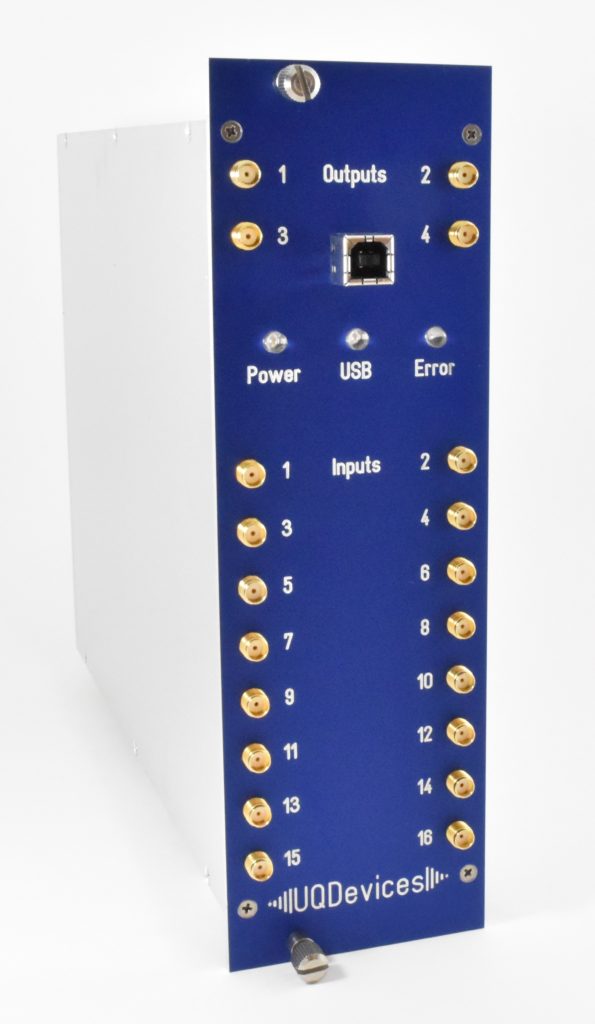
The Logic16 is a logic correlation unit designed to be the most versatile tool available for analyzing photon detection signals in multi-photon correlation counting and time-resolved signal analysis. It operates in two distinct modes for measurement flexibility: coincidence counting mode and time-tagging mode.
Coincidence counting
Logic16’s proprietary on-board coincidence counting algorithms enable users to:
- Count ALL possible coincidence patterns for up to 16 inputs (over 43 million, simultaneously)
- Set inputs to coincidence active, inactive, or ignore
- Use Logic16 with even small, low-power computers since all time-correlation processing is performed internally
Added value for experiment integration
- Flexibility. Users can switch in-lab between Configuration A ( 156 ps resolution, 16 operational channels) and Configuration B
(78 ps resolution, 8 operational channels). - Output pulses triggered by user-selected coincidence pattern detection
- Programmable-delay output pulses
- Versatile pulse generator
- Synchronization of multiple units
- Convenient USB 2.0 interface (11 Mtags/s)
Timetagging
Logic16 time-tagger and time-tag filter enable users to:
- Perform continuous time-tagging over long periods of time (see an implementation using Logic16 to record for 20h [paper citation]
- Perform gated time-tagging
- Employ a time-tag filter to record only those time-tags where a set number of detections have occurred
- Measure with sustained data rates up to 190 MHz by employing a time-tag filter †
- Avoid burdening the host PC with excessively large raw data files that make analysis and post-processing a chore
- Mask inputs of choice from the time-tag filter, allowing select signals (e.g., for timing or synchronization) to pass unfiltered
Specifications
| Configuration A | Configuration B | |
| Number of accessible channels | 16 | 8 |
| Time bin, digital | 156 ps | 78 ps |
| Tunable (multi-hit) delay | ≤+40 μs†† | ≤+20 μs†† |
| On-board coincidence count rate | 100 MHz | 100 MHz |
| On-board time-tag rate (per channel, burst of 1024 events) | 200 MHz | 200 MHz |
| Max. data transfer rate | ~ 11MHz††† | ~ 11MHz††† |
| Max. sustained (time-tag) data rate | 190 MHz† | 190 MHz† |
Shipping information: weight (approx.) 4 lbs; dimensions (approx.) 16″ x 12″ x 4″
† The time tagger operates with a 190 Mtag/s burst rate. So long as detection events occur at ≤ 11MHz (i.e., the USB 2.0 limited transfer rate), this 190 MHz rate can be leveraged
††This maximum delay time is dependent on the buffer, which can store 1024 events/channel over this time period. In other words one can measure events at 25 MHz (50MHz) @ 40 μs (20 μs) delay – and at higher rates for shorter delays.
†††As expected with optimized code (e.g., C++) on a host PC with USB 2.0 interface.
Software and drivers
Please go to the [software] page to download the latest software and drivers.
Logic16 comes with .NET and C++ drivers for Windows and Linux drivers for direct control of the unit using Matlab, Labview, Python, MS visual studio and C++.
Simple program examples using .NET and C++ are available to download from then [software] page. For instructions on how to use the examples please use the pdf documents from the [Documentation] page.
Correlation Counter (Windows only)
For a quick start in the lab, perform coincidence counting and record data with the UQD Correlation Counter:
- Set channel parameters (threshold, polarity, delay)
- Set coincidence patterns for counting
- Save data in CSV format
- Save and reload parameter settings for later use
- Obtain timing histograms
Timetag Explorer (Windows only)
Test installation and operation of the Logic16 on a host computer and debug setup integration using the Timetag Explorer.
- Test and verify all possible input configurations and settings
- Check data acquisition and coincidence counting
- Save time-tag files at high speed
